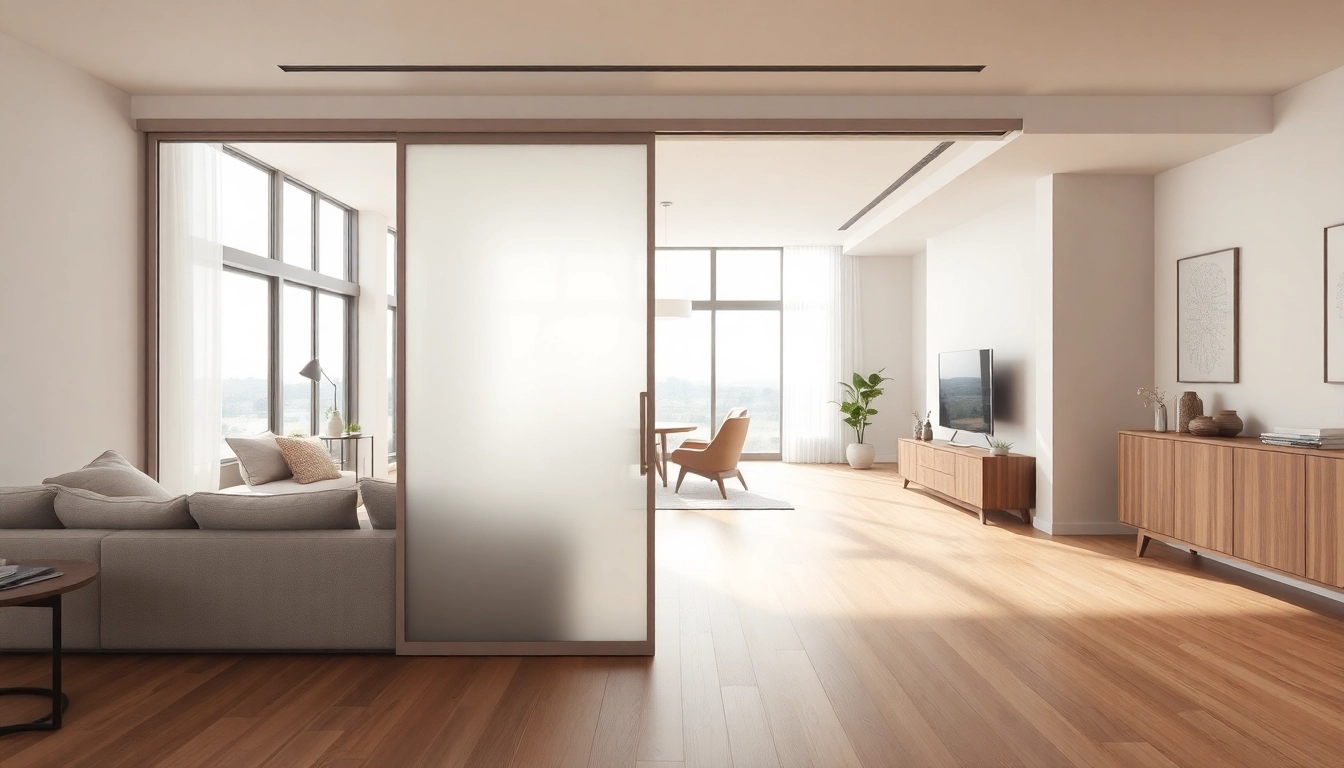
Elevate Your Space with a Sliding Partition Wall: Design, Benefits, and Installation Tips
Understanding Sliding Partition Walls
Definition and Purpose
A sliding partition wall is a versatile architectural feature designed to create flexible spaces within both residential and commercial environments. It serves as a movable boundary that can effectively transform an open area into distinct sections, catering to various functionalities and preferences. This adaptability is particularly beneficial in settings such as offices, classrooms, and homes, where adaptable spaces can enhance functionality and comfort. As architectural trends lean towards multi-use environments, the demand for a sliding partition wall continues to rise, becoming a staple in modern interior design.
Types of Sliding Partition Walls
Sliding partition walls come in several types, each suited to different needs and aesthetics. Below are some popular forms:
- Fixed Track Sliding Partitions: These walls glide on a fixed overhead track, offering seamless operation and great versatility.
- Telescoping Walls: Designed with the ability to slide and stack out of the way, telescoping walls maximize space usage in smaller environments.
- Glass Sliding Partitions: Ideal for situations where light and visibility are essential, these partitions provide an open feel while still allowing for space division.
- Acoustic Sliding Partitions: These are specifically designed to enhance soundproofing between spaces, making them a perfect choice for offices and conference rooms.
- Folding Sliding Walls: These partitions fold and slide to create different space configurations. They are often used in larger venues such as banquet halls or auditoriums.
Key Features and Components
When considering a sliding partition wall, various features and components should be evaluated, including:
- Track System: The track is foundational, allowing for smooth movement. Options include ceiling-mounted or wall-mounted systems.
- Materials: Common materials include wood, metal, and glass, each providing different aesthetic and functional benefits.
- Finishes: Surface finishes can range from laminate to paint, contributing to the overall decor of the space.
- Weight Considerations: The weight of the partition must match the strength of the track system to ensure safe operation.
- Operation Mechanism: Automated or manual mechanisms can enhance convenience and ease of use.
Benefits of Installing a Sliding Partition Wall
Space Optimization and Flexibility
One of the most significant advantages of sliding partition walls is their capacity to optimize space. In environments where every square foot counts, these walls allow areas to be reconfigured quickly and efficiently to suit varying needs. For example, in a corporate office, a room can be divided for meetings during the day and opened up for social gatherings in the evening, all with minimal effort.
This flexibility not only enhances functionality but also promotes a sense of openness when the walls are retracted, making rooms feel larger and more welcoming.
Sound Control and Privacy Solutions
Another essential benefit of sliding partition walls is their ability to provide sound control and privacy. Acoustic sliding partitions are engineered to minimize sound transfer between spaces, making them ideal for environments like schools, medical facilities, and open concept offices. By utilizing sound-absorbing materials and innovative design, these walls can create distinctly separate areas without compromising noise levels.
Design Aesthetics and Style Enhancements
Beyond practicality, sliding partition walls can significantly enhance the aesthetic appeal of a space. With a variety of materials, colors, and finishes available, they can be customized to fit any design theme. From sleek glass panels that add a modern touch to wooden sliding doors that offer a rustic charm, these partitions can serve as statement pieces that elevate the overall decor of a room.
Choosing the Right Sliding Partition Wall
Materials and Build Quality
When selecting a sliding partition wall, the materials and build quality are crucial factors. Durability and aesthetics should both be considered. Popular materials include:
- Wood: Warm, inviting, and suitable for various interior styles.
- Metal: Offers a modern look and is highly durable.
- Glass: Great for maintaining light flow while providing separations.
Additionally, the construction quality plays a pivotal role in the longevity of the partition. Always opt for well-reviewed manufacturers that adhere to quality standards.
Space Considerations and Design Compatibility
Before committing to a particular sliding partition wall, assess your space and design compatibility. Consider the following:
- Room dimensions: Ensure that the chosen partition does not hinder movement or flow.
- Existing decor: Match the materials and styles to the current interior design scheme.
- Functional needs: Define how often the wall will be moved or adjusted to determine the best type for your requirements.
Budgeting for Your Project
Budget is a critical factor in any home improvement project. Higher quality, custom options will typically cost more but offer longer-lasting value. When budgeting, consider the initial costs alongside long-term savings from energy efficiency or sound insulation. Always seek multiple quotes and evaluate the total cost, including installation fees, to avoid any surprises.
Installation Process for Sliding Partition Walls
Preparation and Planning Steps
Before installation begins, proper preparation and planning are essential. Follow these steps:
- Measure Your Space: Obtain precise measurements to determine the appropriate size for the partition.
- Select the Right Product: Based on your budget and needs, choose an appropriate type of sliding partition wall.
- Review Installation Guidelines: Consult the manufacturer’s guidelines for specific installation procedures related to your chosen product.
Tools and Materials Required
For a successful installation, you will need various tools and materials, including:
- Measuring tape
- Drill/screwdriver
- Level
- Stud finder
- Installation brackets and anchors
- Track system components
Step-by-Step Installation Guide
The following is a general guide to installing a sliding partition wall:
- Prepare the Space: Clear the area where the partition will be installed. Ensure walls and floors are clean, dry, and free of obstructions.
- Install the Track: Mark the desired height on the wall and use a level to ensure that the track will be straight. Pre-drill holes to avoid splitting wood, then secure the track using appropriate hardware.
- Attach the Panels: With assistance, lift the sliding panels onto the track, ensuring they move smoothly.
- Adjustments: Adjust the height to ensure the panels slide easily and fit snugly.
- Final Checks: Test the partition’s movement and stability before finishing the installation.
Maintenance and Care for Your Sliding Partition Wall
Regular Cleaning Tips
Maintaining a sliding partition wall is essential for its longevity and functionality. Here are some cleaning tips:
- Use a soft cloth to dust off surfaces regularly.
- For glass partitions, use a glass cleaner to maintain clarity.
- Inspect tracks periodically for debris and clean them to ensure smooth operation.
Common Issues and Troubleshooting
Despite their benefits, sliding partition walls can encounter issues. Common problems include:
- Difficulty Sliding: Check for obstructions or buildup in the track. Cleaning often resolves this.
- Misalignment: If the panels are not aligned properly, review the installation of the track and adjust as necessary.
- Noisy Operation: This could indicate insufficient lubrication; consult manufacturer guidelines for proper maintenance.
When to Seek Professional Help
If installation challenges or maintenance issues become overwhelming, it may be wise to consult a professional. Hiring an expert ensures that the partition wall functions correctly and saves you from potential damage or costly repairs in the future.
